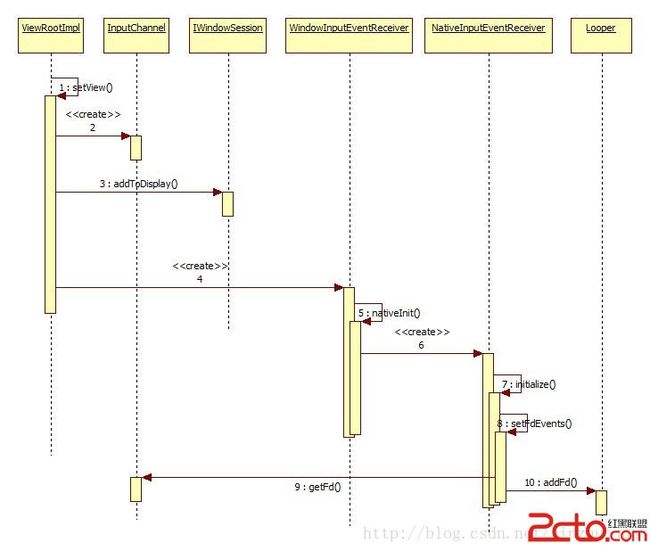android 事件派发流程详解
- Android 5.0(Lollipop)事件输入系统(Input System)
- 2014-12-15 23 个评论 来源:世事难料,保持低调
-
收藏
 我要投稿
我要投稿
 vcPmvavKwrz+zai5/UlucHV0TWFuYWdlcqOsSW5wdXRNb25pdG9y0rvCt7SruPhQaG9uZVdpbmRvd01hbmFnZXLAtNf2z7XNs8rkyOvKwrz+tcS0psDto6zB7dK7t73D5r2r1eLQqcrCvP60q7j4vbm147ywvODK07Swv9qho05hdGl2ZUlucHV0TWFuYWdlcsq1z9ZJbnB1dFJlYWRlclBvbGljeUludGVyZmFjZbrNSW5wdXREaXNwYXRjaGVyUG9saWN5SW50ZXJmYWNlvdO/2qOs1NpOYXRpdmWy47XESW5wdXRNYW5hZ2Vyus1KYXZhsuO1xElNU7zkxvC1vdK7uPa9usuusuO1xNf308Oho0lucHV0TW9uaXRvcsq1z9bBy1dpbmRvd01hbmFnZXJDYWxsYmFja3O907/ao6zG8LW9wctJTVO1vVdNU7XEway909f308Oho0FwcNXisd+jrFZpZXdSb290SW1wbM/gtbHT2kFwcLbL0ru49ralsuNWaWV3tcRDb250cm9sbGVyoaPV4rj2tqWy41ZpZXfU2ldNU9bQttTTptK7uPa0sL/ao6zTw1dpbmRvd1N0YXRlw+jK9qGjV2luZG93U3RhdGXW0NPQSW5wdXRXaW5kb3dIYW5kbGW0+rHt0ru49r3TytXK5MjrysK8/rXEtLC/2r7ksfqho0lucHV0RGlzcGF0Y2hlctbQtcRtRm9jdXNlZFdpbmRvd0hhbmRsZda4yr7By725teO0sL/atcS+5LH6oaNJbnB1dERpc3BhdGNoZXK53MDtwcvSu9vnway906Oo0ru49sGsvdO21NOm0ru49teisuG1vVdNU7XEtLC/2qOpo6zNqLn91eLQqbj2way900lucHV0RGlzcGF0Y2hlcr/J0tTWsb3TvavK5MjrysK8/reizflBcHC2y7XEvbm147Swv9qho8rkyOvKwrz+tNNEcml2ZXK/qsq8tcS0psDtuf2zzLTz1sLI58/Co7o8YnI+CjwvcD4KPHA+PGltZyBzcmM9"http://www.2cto.com/uploadfile/Collfiles/20141215/2014121508324848.png" alt="\">
vcPmvavKwrz+zai5/UlucHV0TWFuYWdlcqOsSW5wdXRNb25pdG9y0rvCt7SruPhQaG9uZVdpbmRvd01hbmFnZXLAtNf2z7XNs8rkyOvKwrz+tcS0psDto6zB7dK7t73D5r2r1eLQqcrCvP60q7j4vbm147ywvODK07Swv9qho05hdGl2ZUlucHV0TWFuYWdlcsq1z9ZJbnB1dFJlYWRlclBvbGljeUludGVyZmFjZbrNSW5wdXREaXNwYXRjaGVyUG9saWN5SW50ZXJmYWNlvdO/2qOs1NpOYXRpdmWy47XESW5wdXRNYW5hZ2Vyus1KYXZhsuO1xElNU7zkxvC1vdK7uPa9usuusuO1xNf308Oho0lucHV0TW9uaXRvcsq1z9bBy1dpbmRvd01hbmFnZXJDYWxsYmFja3O907/ao6zG8LW9wctJTVO1vVdNU7XEway909f308Oho0FwcNXisd+jrFZpZXdSb290SW1wbM/gtbHT2kFwcLbL0ru49ralsuNWaWV3tcRDb250cm9sbGVyoaPV4rj2tqWy41ZpZXfU2ldNU9bQttTTptK7uPa0sL/ao6zTw1dpbmRvd1N0YXRlw+jK9qGjV2luZG93U3RhdGXW0NPQSW5wdXRXaW5kb3dIYW5kbGW0+rHt0ru49r3TytXK5MjrysK8/rXEtLC/2r7ksfqho0lucHV0RGlzcGF0Y2hlctbQtcRtRm9jdXNlZFdpbmRvd0hhbmRsZda4yr7By725teO0sL/atcS+5LH6oaNJbnB1dERpc3BhdGNoZXK53MDtwcvSu9vnway906Oo0ru49sGsvdO21NOm0ru49teisuG1vVdNU7XEtLC/2qOpo6zNqLn91eLQqbj2way900lucHV0RGlzcGF0Y2hlcr/J0tTWsb3TvavK5MjrysK8/reizflBcHC2y7XEvbm147Swv9qho8rkyOvKwrz+tNNEcml2ZXK/qsq8tcS0psDtuf2zzLTz1sLI58/Co7o8YnI+CjwvcD4KPHA+PGltZyBzcmM9"http://www.2cto.com/uploadfile/Collfiles/20141215/2014121508324848.png" alt="\">
为了故事的完整性,还是先看下初始化。SystemServer中初始化IMS,然后初始化WMS,把IMS作为参数传入。
|
1
2
3
4
5
6
7
8
9
|
470
Slog.i(TAG,
"Input Manager"
);
471
inputManager =
new
InputManagerService(context);
472
473
Slog.i(TAG,
"Window Manager"
);
474
wm = WindowManagerService.main(context, inputManager,
475
mFactoryTestMode != FactoryTest.FACTORY_TEST_LOW_LEVEL,
476
!mFirstBoot, mOnlyCore);
...
483
inputManager.start();
|
IMS的构造函数中,调用nativeInit()来初始化。注意这里拿了DisplayThread的Handler,意味着IMS中的消息队列处理都是在单独的DisplayThread中进行的。它是系统中共享的单例前台线程,主要用作输入输出的处理用。这样可以使用户体验敏感的处理少受其它工作的影响,减少延时。整个初始化过程流程如下:
可以看到,初始化时依次初始化NativeInputManager,EventHub,InputManager, InputDispatcher,InputReader,InputReaderThread, InputDispatcherThread。NativeInputManager可看作IMS和InputManager的中间层,将IMS的请求转化为对InputManager及其内部对象的操作,同时将InputManager中模块的请求通过JNI调回IMS。InputManager是输入控制中心,它有两个关键线程InputReaderThread和InputDispatcherThread,它们的主要功能部分分别在InputReader和InputDispacher。前者用于从设备中读取事件,后者将事件分发给目标窗口。EventHub是输入设备的控制中心,它直接与input driver打交道。负责处理输入设备的增减,查询,输入事件的处理并向上层提供getEvents()接口接收事件。在它的构造函数中,主要做三件事:
1. 创建epoll对象,之后就可以把各输入设备的fd挂在上面多路等待输入事件。
2. 建立用于唤醒的pipe,把读端挂到epoll上,以后如果有设备参数的变化需要处理,而getEvents()又阻塞在设备上,就可以调用wake()在pipe的写端写入,就可以让线程从等待中返回。
3. 利用inotify机制监听/dev/input目录下的变更,如有则意味着设备的变化,需要处理。
因为事件的处理是流水线,需要InputReader先读事件,然后InputDispatcher才能进一步处理和分发。因此InputDispatcher需要监听InputReader。这里使用了Listener模式,InputDispacher作为InputReader构造函数的第三个参数,它实现InputListenerInterface接口。到了InputReader的构造函数中,将之包装成QueuedInputListener。QueuedInputListener中的成员变量mArgsQueue是一个缓冲队列,只有在flush()时,才会一次性通知InputDispatcher。QueuedInputListener应用了Command模式,它通过包装InputDispatcher(实现InputListenerInterface接口),将事件的处理请求封装成NotifyArgs,使其有了缓冲执行的功能。
全初始化好后,SystemServer调用start()函数让InputManager中两个线程开始运行。先看InputReaderThread,它是事件在用户态处理过程的起点。这里以按键事件的处理为例。
InputReaderThread不断调用InputReader的pollOnce()->getEvents()函数来得到事件,这些事件可以是输入事件,也可以是由inotify监测到设备增减变更所触发的事件。第一次进入时会扫描/dev/input目录建立设备列表,存在mDevice成员变量中(EventHub中有设备列表KeyedVector mDevices;对应的,InputReader中也有设备列表KeyedVector mDevices。这里先添加到前者,然后会在InputReader::addDeviceLocked()中添加到后者。),同时将增加的fd加到epoll的等待集合中。在接下来的epoll_wait()等待时,如果有事件就会返回,同时返回可读事件数量。在这里,从Input driver读出的事件从原始的input_event结构转为RawEvent结构,放到getEvents()的输出参数buffer中。getEvents()返回后,InputReader调用processEventsLocked()处理事件,对于设备改变,会根据实际情况调用addDeviceLocked(), removeDeviceLocked()和handleConfigurationChangedLocked()。对于其它设备中来的输入事件,会调用processEventsForDeviceLocked()进一步处理。其中会根据当时注册的InputMapper对事件进行处理,然后将事件处理请求放入缓冲队列(QueuedInputListener中的mArgsQueue)。
|
1
2
3
|
155void QueuedInputListener::notifyKey(
const
NotifyKeyArgs* args) {
156
mArgsQueue.push(
new
NotifyKeyArgs(*args));
157
}
|
|
1
2
3
4
5
6
7
8
9
|
171void QueuedInputListener::flush() {
172
size_t count = mArgsQueue.size();
173
for
(size_t i =
0
; i < count; i++) {
174
NotifyArgs* args = mArgsQueue[i];
175
args->notify(mInnerListener);
176
delete args;
177
}
178
mArgsQueue.clear();
179
}
|
以按键事件为例,最后会调用到InputDispatcher的notifyKey()函数中。这里先将参数封装成KeyEvent:
|
1
2
3
4
|
2416
KeyEvent event;
2417
event.initialize(args->deviceId, args->source, args->action,
2418
flags, keyCode, args->scanCode, metaState,
0
,
2419
args->downTime, args->eventTime);
|
|
1
2
3
4
5
6
|
2439
KeyEntry* newEntry =
new
KeyEntry(args->eventTime,
2440
args->deviceId, args->source, policyFlags,
2441
args->action, flags, keyCode, args->scanCode,
2442
metaState, repeatCount, args->downTime);
2443
2444
needWake = enqueueInboundEventLocked(newEntry);
|
可以看到,InputDisptacher的主要任务是把前面收到的输入事件发送到PWM及App端的焦点窗口。前面提到InputReaderThread中收到事件后会调用notifyKey()来通知InputDispatcher,也就是放在mInboundQueue中,在InputDispatcher的dispatchOnce()函数中,会从这个队列拿出处理。
|
1
2
3
4
5
6
7
|
234
if
(!haveCommandsLocked()) {
235
dispatchOnceInnerLocked(&nextWakeupTime);
236
}
...
240
if
(runCommandsLockedInterruptible()) {
241
nextWakeupTime = LONG_LONG_MIN;
242
}
|
其中dispatchOnceInnerLocked()会根据拿出的EventEntry类型调用相应的处理函数,以Key事件为例会调用dispatchKeyLocked():
|
1
2
3
4
5
6
7
8
9
10
11
12
13
14
15
16
|
767
CommandEntry* commandEntry = postCommandLocked(
768
& InputDispatcher::doInterceptKeyBeforeDispatchingLockedInterruptible);
769
if
(mFocusedWindowHandle != NULL) {
770
commandEntry->inputWindowHandle = mFocusedWindowHandle;
771
}
772
commandEntry->keyEntry = entry;
...
791
// Identify targets.
792
Vector
793
int32_t injectionResult = findFocusedWindowTargetsLocked(currentTime,
794
entry, inputTargets, nextWakeupTime);
..
804
addMonitoringTargetsLocked(inputTargets);
805
806
// Dispatch the key.
807
dispatchEventLocked(currentTime, entry, inputTargets);
|
在App端,新的顶层窗口需要被注册到WMS中,这是在ViewRootImpl::setView()中做的。
其中与输入相关的主要有以下几步:
先创建InputChannel,注意还没初始化。
|
1
|
521
mInputChannel =
new
InputChannel();
|
|
1
2
3
|
527
res = mWindowSession.addToDisplay(mWindow, mSeq, mWindowAttributes,
528
getHostVisibility(), mDisplay.getDisplayId(),
529
mAttachInfo.mContentInsets, mInputChannel);
|
ViewRootImpl通过Session中的addToDisplay()会最终调用WMS的addWindow()。在WMS中,会创建一对InputChannel,本质上是一对本地socket。然后一个注册给InputDispatcher,一个作为输出参数传回给App的ViewRootImpl。这样就建立了App与IMS的一对连接。
|
1
2
3
4
5
6
7
8
9
|
2409
if
(outInputChannel !=
null
&& (attrs.inputFeatures
2410
& WindowManager.LayoutParams.INPUT_FEATURE_NO_INPUT_CHANNEL) ==
0
) {
2411
String name = win.makeInputChannelName();
2412
InputChannel[] inputChannels = InputChannel.openInputChannelPair(name);
2413
win.setInputChannel(inputChannels[
0
]);
2414
inputChannels[
1
].transferTo(outInputChannel);
2415
2416
mInputManager.registerInputChannel(win.mInputChannel, win.mInputWindowHandle);
2417
}
|
|
1
2
3
4
5
6
|
3327
sp
new
Connection(inputChannel, inputWindowHandle, monitor);
3328
3329
int
fd = inputChannel->getFd();
3330
mConnectionsByFd.add(fd, connection);
...
3336
mLooper->addFd(fd,
0
, ALOOPER_EVENT_INPUT, handleReceiveCallback,
this
);
|
回到App端,如果前面没啥问题,接下来会创建WindowInputEventReceiver,它是App的事件接收端。
|
1
2
|
607
mInputEventReceiver =
new
WindowInputEventReceiver(mInputChannel,
608
Looper.myLooper());
|
接下来初始化App端事件处理的流水线,这里使用了Chain of responsibility模式,让事件经过各个InputStage,每一个Stage可以决定是否自己处理,也可以传递给下一家。下一家也是如此。在后面的handleEvent()可以看到它们的用法。
|
1
2
3
4
5
6
7
8
9
10
11
12
13
14
15
|
623
// Set up the input pipeline.
624
CharSequence counterSuffix = attrs.getTitle();
625
mSyntheticInputStage =
new
SyntheticInputStage();
626
InputStage viewPostImeStage =
new
ViewPostImeInputStage(mSyntheticInputStage);
627
InputStage nativePostImeStage =
new
NativePostImeInputStage(viewPostImeStage,
628
"aq:native-post-ime:"
+ counterSuffix);
629
InputStage earlyPostImeStage =
new
EarlyPostImeInputStage(nativePostImeStage);
630
InputStage imeStage =
new
ImeInputStage(earlyPostImeStage,
631
"aq:ime:"
+ counterSuffix);
632
InputStage viewPreImeStage =
new
ViewPreImeInputStage(imeStage);
633
InputStage nativePreImeStage =
new
NativePreImeInputStage(viewPreImeStage,
634
"aq:native-pre-ime:"
+ counterSuffix);
635
636
mFirstInputStage = nativePreImeStage;
637
mFirstPostImeInputStage = earlyPostImeStage;
|
连接建立后,接下来要考虑WMS如何将焦点窗口信息传给InputDispatcher。举例来说,当新的窗口加入到WMS中,一般焦点会放到新加窗口上。来看下WMS中的addWindow()函数。
首先,当焦点需要变化时。当焦点窗口变化时,WMS调用
|
1
|
mInputMonitor.setInputFocusLw(mCurrentFocus, updateInputWindows);
|
|
1
|
mInputMonitor.updateInputWindowsLw(
true
);
|
|
1
|
mService.mInputManager.setInputWindows(mInputWindowHandles);
|
基本流程比较直观,先接收事件,然后放入ViewRootImpl的处理队列,然后dispatch给View处理,经过上面提到的一系列InputStage,最后App处理完事件后还需要向IMS发送一个完成信号。
注意上面是以Key事件为例的。对于Motion事件就有差别了。因为触摸移动中的事件不一定要每一个都处理,因为显示也就60HZ,你如果100HZ的输入事件,全处理只会浪费计算资源。上面这条路是每当InputDispatcher有事件发过来时就会触发的,而对于Motion事件,系统会把一个VSync周期内的事件存为Batch,当VSync到来时一起处理。从JB开始,App对输入事件的处理是由VSync信号来驱动的。可以看Choreographer中的VSync回调中首先处理的就是输入事件。
|
1
2
3
|
542
doCallbacks(Choreographer.CALLBACK_INPUT, frameTimeNanos);
543
doCallbacks(Choreographer.CALLBACK_ANIMATION, frameTimeNanos);
544
doCallbacks(Choreographer.CALLBACK_TRAVERSAL, frameTimeNanos);
|
|
1
2
|
448
if
(canAddSample(batch, &mMsg)) {
449
batch.samples.push(mMsg);
|
ViewRootImpl中维护了pending input event的列表,用mPendingInputEventHead和mPendingInputEventTail指示,其中的元素为QueuedInputEvent类型。这个队列会由InputEventReceiver调用enqueueInputEvent()加入元素,然后ViewRootImpl延时或非延时在doProcessInputEvents()中读出并处理。处理的方法如前图调用deliverInputEvent(),然后调用InputStage的deliver()方法进行处理。最后调用finishInputEvent()向IMS发送完成信息,它实际是调用了NativeInputEventReceiver::finishInputEvent(),该函数内部使用InputConsumer的sendFinishedSignal()发送处理结束信号。
事实上,当Input resample机制打开时(系统属性ro_input.noresample控制),对于Motion事件在InputConsumer里的处理会更复杂一点。Android在InputConsumer中加入了对Motion事件的重采样。VSync代表Display已完成一帧的显示,系统需要准备下一帧,也就是说我们需要知道VSync信号来到时触摸的坐标。那么问题来了,输入设备的事件不是按VSync来的,比如是10ms为周期(VSync周期为16.67ms)。那么怎么知道VSync的时刻的输入坐标呢,只能靠估计。怎么估计呢,靠的是采样加上内外插值结合的估值方法。详细可参见http://www.masonchang.com/blog/2014/8/25/androids-touch-resampling-algorithm 。
前面提到,InputDispatcher除了给App端传事件外,还有个任务是处理系统按键。系统中有一些特殊的按键,是系统需要处理的,如音量,电源键等。它是通过interceptKeyBeforeDispatching()和interceptKeyBeforeQueueing()两个函数来截获的。interceptKeyBeforeDispatching()主要用于处理home, menu和search,interceptkeyBeforeQueueing()主要用于处理音量和电源键。这些处理的实现都放在PWM中,而调用者是在InputDispatcherThread。这样的好处是把平台相关的东西都放在PWM中,而InputDispatcher中是平台通用的东西,厂商要定制策略只需修改PWM。这样,做到了Mechanism和Policy的分离。那InputDisaptcher是如何调用到PWM中的呢?首先InputDispatcher中的代码中有几个hook的地方:
|
1
2
|
3510
nsecs_t delay = mPolicy->interceptKeyBeforeDispatching(commandEntry->inputWindowHandle,
3511
&event, entry->policyFlags);
|
|
1
2
3
4
5
|
1463
// Native callback.
1464
private
long
interceptKeyBeforeDispatching(InputWindowHandle focus,
1465
KeyEvent event,
int
policyFlags) {
1466
return
mWindowManagerCallbacks.interceptKeyBeforeDispatching(focus, event, policyFlags);
1467
}
|
|
1
2
3
4
5
|
380
public
long
interceptKeyBeforeDispatching(
381
InputWindowHandle focus, KeyEvent event,
int
policyFlags) {
382
WindowState windowState = focus !=
null
? (WindowState) focus.windowState :
null
;
383
return
mService.mPolicy.interceptKeyBeforeDispatching(windowState, event, policyFlags);
384
}
|
可以看到,从Input driver中读出的是input_event结构,之后在经过中间模块时会按需对其进行封装,变成或被封装进RawEvent, KeyEntry, DispatchEntry, InputMessage, InputEvent, QueuedInputEvent等结构。其中有些结构是对另一些结构的封装,如DispatchEntry中封装了KeyEntry,QueuedInputEvent是对InputEvent的封装等。
回到主线,故事来没讲完。上面说到App这端处理完输入事件,然后通过和IMS中InputDispacher的通信管道InputChannel发了处理完成通知。那InputDispatcher这边收到后如何处理呢?
InputDispatcher会调用handleReceiveCallback()来处理完成信号。这里先是往Command队列里放一个处理事务执行doDispatchCycleFinishedLockedInterruptible(),后面在runCommandsLockedInterruptible()中会取出执行。在doDispatchCycleFinishedLockedInterruptible()函数中,会先调用afterKeyEventLockedInterruptible()。Android中可以定义一些Fallback键,即如果一个Key事件App没有处理,可以Fallback成另外默认的Key事件,这是在这里的dispatchUnhandledKey()函数中进行处理的。接着InputDispatcher会将该收到完成信号的事件项从等待队列中移除。同时由于上一个事件已被App处理完,就可以调用startDispatchCycleLocked()来进行下一轮事件的处理了。
|
1
2
3
4
5
6
7
8
9
10
11
|
3558
// Dequeue the event and start the next cycle.
3559
// Note that because the lock might have been released, it is possible that the
3560
// contents of the wait queue to have been drained, so we need to double-check
3561
// a few things.
3562
if
(dispatchEntry == connection->findWaitQueueEntry(seq)) {
3563
connection->waitQueue.dequeue(dispatchEntry);
...
3571
}
3572
3573
// Start the next dispatch cycle for this connection.
3574
startDispatchCycleLocked(now(), connection);
|










